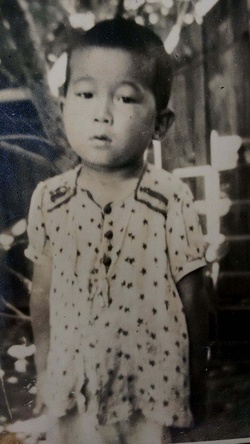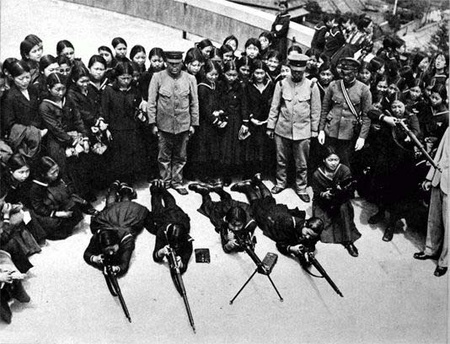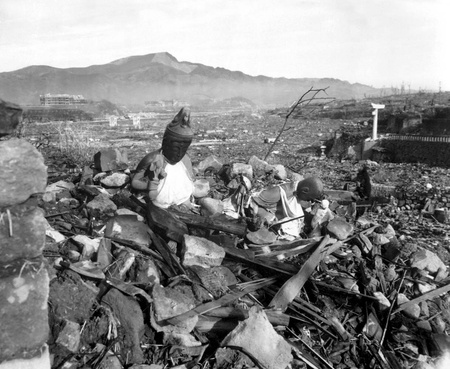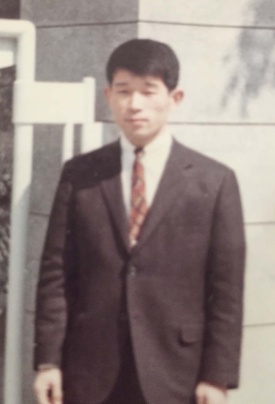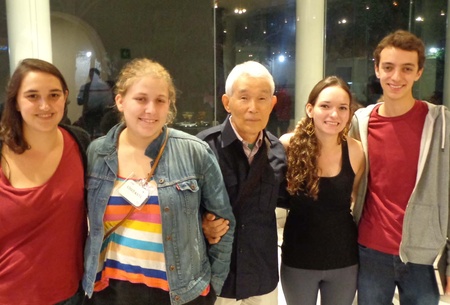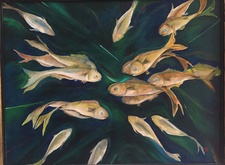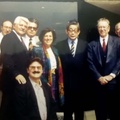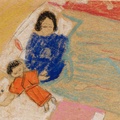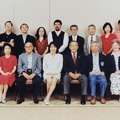Although Yasuaki grew up during the most difficult part of the war, he still had fun playing with his friends and trapping crickets and cicadas in the mountains near his home. The children were used to the wailing sirens that announced the arrival of the American bombers. The people knew they were supposed to enter the air raid shelters when the alert sounded, as had already happened several times before the atomic bomb was dropped.
Yasuaki accompanied his mother to neighborhood meetings where residents organized themselves and received military training. The neighborhood organization, known as tonarigumi, played a key role in sustaining the war effort. Toward the end of the war, women began receiving training in the use of bamboo spears, to defend themselves against the U.S. army if it succeeded in occupying Japan.
Although the military commanders insisted in their propaganda that Japan could not be defeated, they simultaneously promoted the spirit of gyokusai among the people; that is, the idea that it was better to die honorably than capitulate or surrender to the enemy. Even after the first atomic bomb was dropped on Hiroshima on August 6, the Supreme Council made the decision to continue fighting the war to the end, defying Emperor Hirohito himself.
Yasuaki’s family was large: in addition to his father and mother, there were six siblings. The three oldest brothers had been recruited into the army, while the three sisters attended school. Yasuaki’s father worked for one the largest and most important companies in Japan: Mitsubishi. This large conglomerate, or zaibatsu, manufactured weapons and airplanes and was in charge of the Nagasaki shipyards, so it was one of the bombing targets chosen by the U.S. army.
On August 9, when the bomb was dropped at 11:02 in the morning, Yasuaki hadn’t gone out with his friends to look for insects. Along with his mother and one of his sisters, he listened to the siren and radio warning that an enemy plane was approaching, so they entered the house on their way to the shelter underneath. Before they reached the shelter, they felt an intense light that blinded them and then a tremendous force threw them to the ground.
Yasuaki’s mother was able to protect him with her body; crawling through the darkness, they entered the shelter as countless objects flew around them. The house had been destroyed; only the columns supporting the roof and some walls remained. Yasuaki’s sister told her mother that some oil had fallen on her head, but it was actually blood from cuts caused by broken glass. After a few minutes, they began walking toward a shelter in the mountains, from where they could observe the few buildings that remained intact in the city and the fires all around.
Yasuaki’s father, sisters, and friends also arrived at the community shelter in the mountains. One of the girls had burns all over her back and died the next day. Under instructions from the authorities, Yasuaki’s father and hundreds of other volunteers went to the epicenter of the explosion to help the survivors, finding thousands of cadavers. Because he worked day and night in that area, Mr. Yamashita was exposed to intense radiation, which made him take ill suddenly. He died several months later. It has been estimated that more than 70,000 people were killed instantly by the explosion or died in the weeks afterward.
In the weeks following the dropping of the bomb, the suffering of the people increased because of lack of food, while the number of wounded and dead rose each day. To find something to eat, Yasuaki’s mother decided to take the children to stay with relatives who lived outside the city. To get there, they had to walk through the area where the bomb had fallen, where they saw thousands of charred bodies that couldn’t be removed.
After a few days, Yasuaki and his mother and sisters returned to Nagasaki, unable to find enough provisions. Using the burned walls and materials they were able to recover from the ruins, they rebuilt and covered the largest holes in the house so at least they wouldn’t have to sleep outdoors.
In the following months the situation of the population changed radically in the face of almost total destruction of the cities and the country’s economy, as well as the occupation by U.S. forces. Yasuaki entered primary school. Most of the children attended school without shoes and wearing mended clothing because of the total lack of such goods, which could only be obtained in the black market for exorbitant prices. The textbooks distributed in the schools were the same ones used during the war, but the children crossed out the paragraphs praising the Emperor and Japan’s era of militarism.
The worst aspect of those years continued to be the scarcity of food, which resulted in famine. The U.S. army had to distribute provisions in the schools. Yasuaki remembers vividly the day he drank powdered milk and ate raisins and some crackers that seemed to him like manna from heaven.
Encounters between the soldiers and the population during the U.S. occupation were unexpected and surprising for both sides. The U.S. soldiers weren’t the “demons” with horns that Yasuaki and his friends had imagined, based on the information the Japanese military disseminated during the war. Nor was the Japanese population a horde of barbarians and fanatics, as the U.S. government had sustained. Both the Japanese and U.S. war propaganda had reached such an extreme as to propose that only extermination of the enemy would end the war. The U.S. troops found, on the contrary, a population ready to help while the Japanese population encountered a U.S. army that was disciplined, educated, and orderly—even friendly—such that the soldiers didn’t fire a single bullet during the seven years of occupation.
The struggle faced by the Japanese after the war was centered around the reconstruction of the country, which was in ruins. Yasuaki’s sister began working to earn some money and Yasuaki himself delivered newspapers to help support the family after his father died.
When Yasuaki was about to finish high school, he was stricken with a strange illness that manifested in hemorrhaging that appeared suddenly and caused him to faint as a result of sudden anemia. The medical tests he underwent showed no apparent explanation for these problems and to this day, a cause for them has never been determined. Because of the fainting, Yasuaki was unable to find a permanent job, since he frequently ended up in the hospital. It wasn’t until 1960 that he began working at the Japanese Red Cross Hospital for atomic bomb survivors, Nagasaki Genbaku Byoin, as a department administrator.
In the hospital, Yasuaki became fully aware of the extent of the effects of the atomic bomb in causing a variety of diseases among the hibakusha, or survivors. Yasuaki’s work was not only administrative; he began to develop a very intense relationship with the patients, through direct contact with babies who were born with deformations and numerous patients with cancer caused by radiation exposure. In particular, he was greatly impressed by a young man his age who was diagnosed with leukemia and to whom Yasuaki donated blood every time he needed it. The physical deterioration and subsequent death of this young man greatly marked Yasuaki, such that every time he looked in the mirror, he was reminded that he could himself become ill at any time.
But Yasuaki was also the victim of discrimination caused by unfounded fear from one part of the population that believed they could be “infected by” the diseases of people exposed to radiation. Young women, in particular, faced rejection and found it difficult to find a husband because of the possibility that their children would be born with birth defects. From that time, Yasuaki hid the fact that he had survived the bombing and refused to talk about his experience, beginning a long period of silence on that chapter of his life. Japanese writer Kenzaburo Oe, who was awarded the Nobel Prize for literature in 1994, has explained this behavior, pointing out that only survivors are entitled to remain silent if they wish to, as they attempt to forget that terrible experience.
During this stage of his life, young Yasuaki developed an interest in Mexico. What was it about that country that caught his attention?
First, it was the music: A trio known as Los Panchos who sang boleros became very popular in Japan and even recorded their songs in Japanese. In addition, learning about Mexican culture, mural painting, and the history of the Meso-American peoples began to arouse interest among the Japanese people. A book by painter Tamiji Kitagawa, who lived in Mexico before the war, represented for Yasuaki another important incentive to study the history of that country and he also began studying Spanish with great enthusiasm and dedication.
Although he had a good job at the hospital, the pain of the patients and his desire to move away from that environment so full of suffering and discrimination motivated Yasuaki to seek, almost obsessively, a way to travel to Mexico. The occasion presented itself in 1968 during the Olympic Games in Mexico: the Japanese delegation needed a young person to work as an interpreter, and Yasuaki was quickly chosen.
When the Olympics were over, he decided to stay in Mexico and look for a job, which would enable him not only to deepen his knowledge of the Spanish language but also of pre-Hispanic peoples and their culture. He took several courses at the National Museum of Anthropology and began traveling to all of the archaeological zones in the country. His profound interest in Mexican culture led him to study the Náhautl language, so he could directly communicate with indigenous people.
As a result of the expansion and rapid growth of the Japanese economy during these decades, hundreds of Japanese companies installed plants and offices in Mexico. With his command of the Spanish language, in early 1970 Yasuaki began working with company executives as an interpreter and translator. Because the work was intense and well-paid, in addition to his interest in the culture and people of Mexico, Yasuaki decided to stay in that country, and even applied for Mexican citizenship.
Moreover, Yasuaki believed that the Mexican and Japanese cultures were not as different as they seemed to be, with Shintoist philosophy sharing many common aspects with the philosophy of the Meso-American peoples.
It wasn’t until 1995 that Yasuaki decided to break his silence as a hibakusha. In the city of Querétaro, a group of young people invited him to give a talk on his experience as a survivor of the atomic bomb, since they knew he had been born in Nagasaki. Initially Yasuaki flatly refused, but he eventually agreed to give a talk. The lectures and conferences that he began to participate in starting at that time became for Yasuaki a kind of balm or therapy that enabled him to mitigate the enormous pain he had previously kept to himself.
Yasuaki also decided to contribute his personal effort to the global movement against the use of nuclear weapons and in favor of peace. This led him to join organized groups of survivors of the atomic bomb in the United States as well as organizations that promote nuclear disarmament in several countries.
Yasuaki has been an untiring crusader who travels to numerous countries around the world to share, in clear detail, his experience in Nagasaki. He has presented numerous times in organizations such as the United Nations and for various governments, explaining his reasons for opposing the complete destruction of the nuclear arsenal. The work that Yasuaki carries out with young people is something he is particularly passionate about. He visits many schools to ensure that the students will share his words and continue his fight against atomic weapons. The disaster at the nuclear terminal at Fukushima in 2011 in Japan, after the earthquake and tsunami, demonstrated that even peaceful use of atomic energy for power plants could result in the end of humanity.
At 77 years of age, Yasuaki is passionate about two activities: His work on behalf of the peace movement, as his Japanese name signifies (保昭), to ensure that no one else has to suffer the consequences of an atomic tragedy like the one experienced by the people of Nagasaki and Hiroshima. With the same intensity, his paintings and pottery have led to recognition and awards as an artist. He currently lives in San Miguel Allende, Guanajuato.
Kenzaburo Oe’s definition of the character of the hibakusha is accurate; he says that when they decide to speak, they do so with all of their energy. None of us, notes the Japanese writer, should remain passive or merely moved by their stories; rather, we should “accompany them because it is the only way we can continue being true human beings.”
© 2016 Sergio Hernández Galindo


